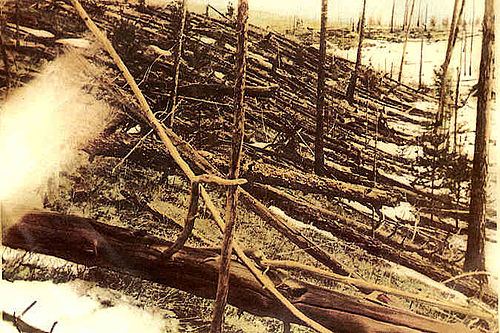
On June 30, 1908, a massive explosion rocked the remote region of Tunguska in Siberia, devastating thousands of hectares of forest and causing a shockwave felt hundreds of kilometers away. This event, known as the Tunguska Event, remains one of the greatest unsolved mysteries in history.
The explosion occurred near the Podkamennaya Tunguska River in what is now the Krasnoyarsk region of Russia. Witnesses reported seeing a fiery ball of light streaking across the sky, followed by an extremely powerful explosion. The resulting shockwave uprooted trees over hundreds of square kilometers and was detected as far as Europe.
The consequences of the explosion were staggering. Thousands of trees were uprooted and broken, forming a circular area of devastation of about 2,000 square kilometers. Reports from expeditions that reached the area years later described an apocalyptic landscape with shredded and charred trees for dozens of kilometers.
However, despite the magnitude of the explosion, no impact crater was found. Research conducted in the years following the event failed to locate any fragments of an asteroid or meteorite that could have caused such destruction. This lack of tangible evidence has fueled numerous theories and speculations about the true nature of the event.
One of the most popular theories is that the explosion was caused by the impact of a meteorite or asteroid. However, the absence of a crater has posed a challenge to this theory. Some researchers argue that an asteroid could have exploded in the atmosphere before hitting the ground, thus explaining the lack of a crater, but this hypothesis has not been confirmed yet.
Another theory suggests that the explosion was the result of an extraterrestrial object, such as a spaceship or probe, entering Earth's atmosphere. However, there is no solid evidence to support this theory, and it is widely regarded as speculative.
Some more controversial theories have even proposed that the explosion was caused by a paranormal phenomenon or a secret scientific experiment. However, these ideas also lack credible evidence and are often seen as pseudoscience.
Despite decades of research and speculation, the Tunguska Event remains an unsolved mystery. It continues to fascinate scientists and amateur astronomers alike, and efforts to uncover the truth behind this enigmatic event are ongoing.
Vizu, Public domain, https://en.wikipedia.org/wiki/Tunguska_event#/media/File:Tunguska_Ereignis.jpg


0 comments: